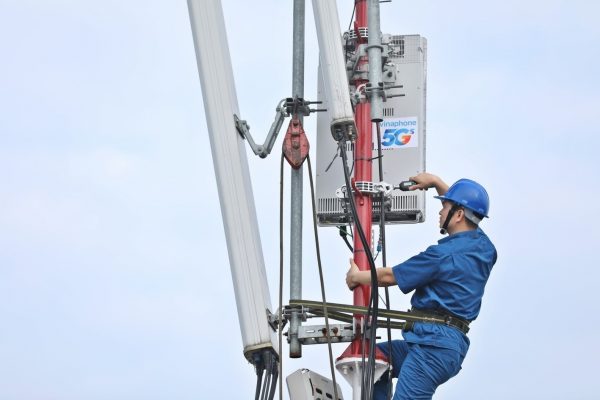Amid the COVID-19 pandemic and rising US–China trade tensions, Vietnam leapfrogged South Korea to become the United States’ sixth largest trade partner by import value in 2022. This jump represents an important pivot in Vietnam’s economy — Vietnam’s biggest export to the United States is no longer textiles and garments, but high-tech products.
By the end of 2023, many flagship Apple products will have been assembled in Vietnam. Rather than competing against China’s ‘world factory’ tag, Vietnam has branded itself as an additional manufacturing destination to China within the global supply chain ecosystem. In so doing, Vietnam has subsumed some of China’s tech export market share and has been declared the biggest beneficiary of the US–China economic decoupling.
Vietnam has provided a much needed ‘neutral’ environment for foreign fintech firms to de-risk and reroute their exposure from the US–China great power rivalry — including Apple’s shift of production away from China, US-based Amkor Technology’s investment of $1.6 billion investment in a semi-conductor factory. Vietnam is also welcoming back Huawei after initially deferring to US efforts to ban the company.
Vietnam has the potential to become the fourth largest exporter of high-tech goods behind China, Taiwan and Germany. Though Vietnam currently holds seventh position, its growth has no rival — high-tech goods as a share of Vietnamese exports hit 42 per cent in 2020, up from 13 per cent in 2010.
By some accounts, Vietnam is ‘shadowing’ China in its efforts to become an upper-middle income economy. But unlike China, Vietnam’s state capitalism is seen as non-threatening to Western and Asian economies. Through its ‘independent’ foreign policy, Vietnam is able to hedge and thrive in today’s geopolitical environment.
Vietnam is an autocratic regime with a very poor human rights record whose state-owned enterprises significantly crowd out private sector innovation. At the same time, others have recognised that the Vietnamese government’s intervention in opening the country up for free trade and foreign direct investment can be seen as overwhelmingly positive and non-threatening to the global trading system.
Vietnam’s model of state capitalism is indeed compatible with market-driven economic growth. In a seminal work on the variations of state capitalism, three dimensions of state capitalism were identified. The first is whether government intervention is threatening or non-threatening, the second is the degree of state ownership and the last is statism, or the level of coordination between state actors and non-state actors in sectors such as education and healthcare. Countries can exhibit high ratings on one factor and low ratings on another.
While the Vietnamese government is strongly embedded in all sectors of society, statism in Vietnam often tolerates and responds positively to citizens’ criticism — particularly in areas relating to public corruption, climate change, education and public health.
But Vietnam’s meteoric rise in high-tech exports has yet to speed up its entry into the exclusive club of ‘Asian tiger’ economies. In previous decades, South Korea, Taiwan and China have entered the club by climbing from low-tech manufacturing to advanced high-tech production. It might take about 15 years for Vietnam’s GDP per capita — which was US$4320 in 2023 — to reach China’s 2023 GDP per capita of US$12,540.
While Apple is tasking its suppliers to invest, produce and assemble products in Vietnam, the question is whether Vietnam can capture value-added opportunities and see Vietnamese firms gradually becoming Apple suppliers. This seems unlikely in the short term, as all of Apple’s suppliers are Chinese or Taiwanese foreign-invested firms who have relocated to Vietnam.
While Vietnam’s high-tech exports are fuelling the country’s growth, there is an overreliance on foreign innovation inputs, with about 70 per cent of Vietnam’s total export value driven and captured by foreign companies. Vietnam’s GDP per capita’s growth potential is significantly lower than that of other Asian tigers after reaching lower middle-income status. This is because Vietnam’s total factor productivity and human capital have yet to be driven by domestic inputs, and technology spillovers aren’t occurring fast enough.
But there is a significant bright spot — the current FDI inflows from fintech companies are giving Vietnam more time to address its dependency on foreign innovation inputs. For instance, the Vietnamese government could entice Apple to invest in research and development and deepen its relationships with Vietnamese universities and students, as Apple did in China.
Vietnam has uniquely positioned itself to be among the fastest growing economies in the coming decade. And its success in managing COVID-19 as Asia’s top performing economy during the pandemic has strengthened the country’s statism and reputation as a safe and friendly environment for foreign direct investment.
Vietnam’s race to becoming the next Asian tiger has its challenges, including the question of how to reduce the country’s overreliance on foreign innovation inputs. But it appears that core elements of an innovation ecosystem are taking root as Vietnam establishes itself as a high-tech export power.
Amid deglobalisation and a global pandemic, Vietnam has emerged as an outlier, showing that its state capitalism is a capable growth model. Vietnam has secured more time — if not an inside track — in the race to become the next Asian tiger.
Long Le is Director of the International Business Program the Leavey School of Business at Santa Clara University. He is also an affiliated Senior Research Associate for the University of Oregon’s US–Vietnam Research Center. His opinion is his own.

